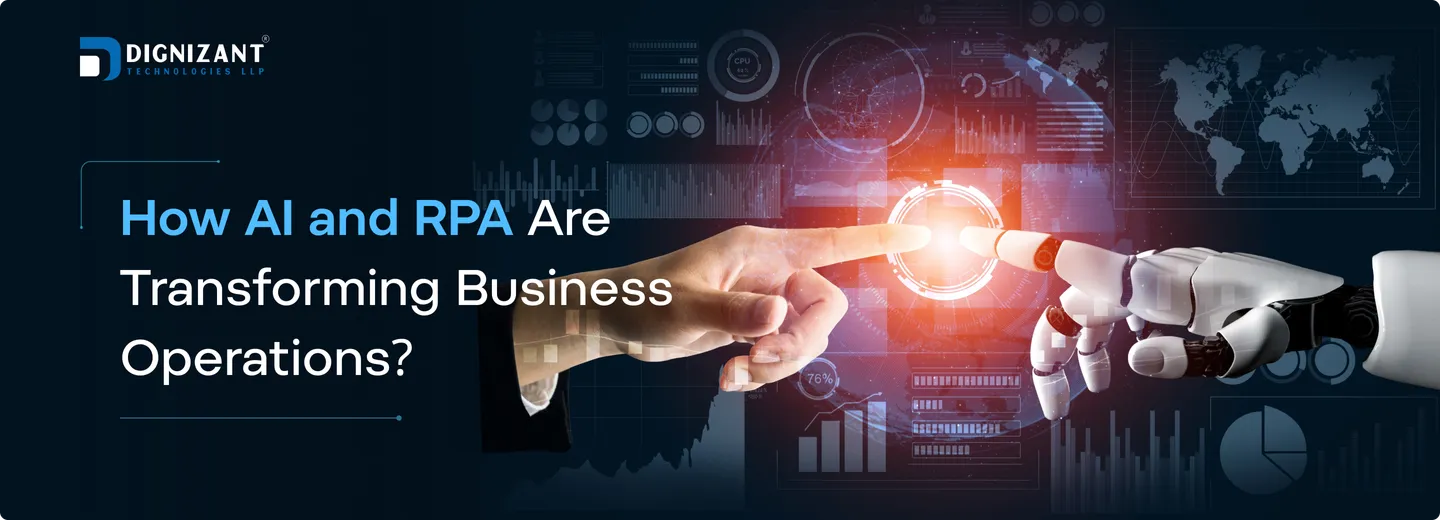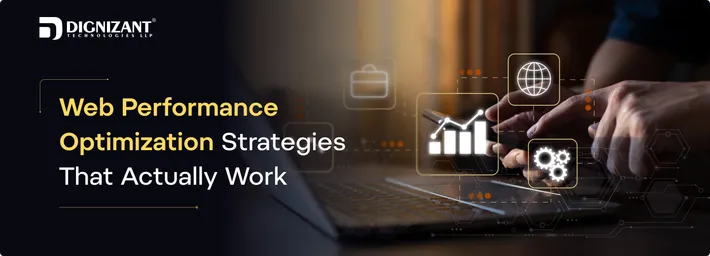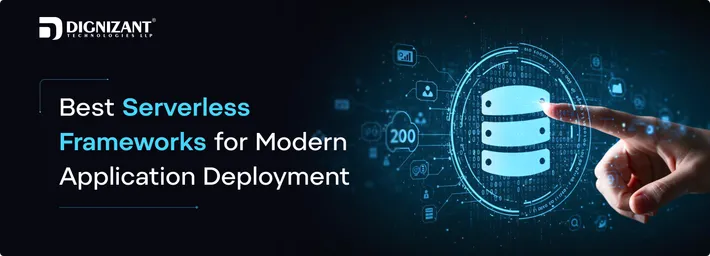How AI and RPA Are Transforming Business Operations?

Contributor
Vinil Joseph
Uploaded
19 August, 2025
Read Time
5 Minutes
In the digital-first era we live in today, enterprises are continuously challenged to innovate, simplify operations, and provide better customer experiences. Artificial Intelligence (AI) and Robotic Process Automation (RPA) are two of the technologies leading this revolution. Together, they are changing the way that companies are doing business making businesses more effective, lowering costs and driving smarter business.
For organizations looking to be competitive, leveraging AI and ML development services in conjunction with RPA solutions isn’t a choice, it's critical to their future survival. These services enable organizations to develop intelligent solutions that learn, predict, and operate within a world of users, apps, and devices.
Understanding the Difference
But first, a look at how they work and what they mean:
Artificial Intelligence (AI): Unlike in Psychology, AI aims at emulating human intelligence using methods, based on data. It teaches machines how to learn, predict and make decisions. AI gives businesses cognitive powers from natural language processing to predictive analytics.
Robotic Process Automation (RPA): It streamlines rules-based, repetitive tasks facilitated by software bots. It doesn’t think or learn, as AI does, but it is incredibly efficient at menial tasks like copying data, generating reports or processing financial transactions quickly and without error.
Together, AI to RPA forms a corresponding model known as intelligent automation that supports making both structured and unstructured workloads work best for the businesses that employ them.
Why Businesses Are Turning to AI and RPA
The adoption of AI and RPA is not just about reducing costs, it’s about developing smarter, scalable and future-ready enterprises. Key drivers include:
- Growing pressure to minimize operational limitations.
- Increasing customer expectations for speed and personalization.
- The need for scalability without proportionally increasing workforce costs.
- Rule-based requirements demanding higher accuracy and compliance.
Key Features of AI and RPA in Business Operations
1. Streamlining Repetitive Workflows
The bots will perform laborious tasks such as invoice processing, payroll management as well as compliance testing with a level of accuracy that is unparalleled. Removing human error keeps the business that much more accurate and consistent with operations. This is a way to take the focus off employees who need the opportunity to work on creative, troubleshooting and strategic tasks that add increased value.
2. Enhancing Decision-Making with AI
AI allows businesses to process massive amounts of data in real time finding trends and actionable information. From anticipating market changes to fine-tuning supply channels, it slashes guess work from major decisions. In the process, leaders will be able to make faster, data-informed decisions which translate to better outcomes and increased competitiveness.
3. Improving Customer Experience
AI-powered chatbots, recommendation engines and sentiment analysis tools deliver more customized customer exchanges. Meanwhile, RPA offers simplified backend processes to help reduce customer delays or problems. This combination creates trust, loyalty, and satisfaction and thereby enhance the customer journey overall.
4. Reducing Costs and Increasing Efficiency
RPA bots labor 24/7 never taking a break, lowering needs for manual intervention and adding staff. Meanwhile, AI is facilitating resource allocation optimization, so teams and systems are peak productive. Working as a team to reduce overhead expenses, they provide a better level of performance and more reliable features.
5. Ensuring Compliance and Reducing Risk
RPA automatically creates comprehensive audit trails, so reporting compliance is simple and transparent. AI enhances security by picking-up fraud patterns, anomalies, and other suspicious behavior before they become a scourge. This two - tier process not only protects the business but also reduces the risk of damage to finances and reputation.
6. Enabling Seamless Scalability
As the business grows, it enables the operations to scale without the commensurate growth in the work force. They mechanically run their course and quickly adjust to stronger demands, always dependably. This allows for a much smoother, faster and wildly more cost-effective expansion than before.
Emerging Trends in AI and RPA
1. Rise of Hyperautomation
Hyper automation is the combination of AI, RPA, machine learning and process mining with the intent to automate complete end-to-end processes, not just isolated tasks. It provides companies the ability to integrate multiple automation technologies for optimal performance and agility. Since Gartner listed hyperautomation as a Top 10 strategic technology trend, companies leveraging it will be ahead of the competition in competitiveness and innovation.
2. Conversational AI Integration
Conversational AI integrated with NLP-based chatbots is getting combined with RPA for handling customer-facing and backend processes. This turns into intelligent digital workers who can respond to questions, action requests and invoke automated workflows in real time. The payoff is the kind of integrated, always-on customer service that can provide gains in internal operations as well.
3. AI-Powered Predictive Analytics
Companies have been turning to AI to predict customer behavior, monitor changing markets and simplify supply chains. Using huge data sets, predictive analytics transforms raw data into a look ahead. This is how policy-makers can be on the front-foot, rather than the back, to gain a competitive advantage.
4. Democratization of Automation
Companies using these low-code and no-code RPA options are able to put automation in the hands of non-technical workers. As a result, these “citizen developers” can design, test and deploy automation solutions with much less dependence on the IT teams. This democratization promotes rapid innovation across the business groups and a culture of true digital enablement.
5. Industry-Specific Solutions
Custom built AI and RPA solutions are revolutionizing industries by solving placebase challenges unique to every sector. It improves diagnostics and patient service in healthcare, and fraud identification and compliance in the finance sector. With increased specialization automation across industries, comes increased precision, production, and customer confidence.
Practical Implementations Across Sectors
- Banking & Finance: Fraud protection, automatic loan approval, and risk management.
- Health: AI diagnostics, patient record automation and insurance claim automation.
- Retail & E-commerce: Recommendation systems based on user preferences, stock management and automated order fulfillment.
- Assembly and manufacturing: Predictive maintenance, product quality control and enrichment of the supply chain.
- HR & Admin: Resume parsing, onboarding automation, and employee performance analysis.
Future Outlook: The Era of Hyperautomation
The future of business operations is hyperautomation, a fusion of AI, RPA, analytics and other technologies. Companies that adopt this shift can trigger:
What to Expect Next:
- Greater personalization in customer journeys
- End-to-end automation of hard workflows
- Increased concentrate on ethical AI and responsible automation
- Enhanced collaboration between humans and digital bots
- Growth into other sectors from agriculture to education
Businesses investing in AI and ML development services today will benefit immensely by being more nimble, scalable, and future-proof.
Conclusion
It is not just spoken of as things of the future, but as applications currently in use to transform operations. Utilizing workflow automation, analytics and machine learning, they enable companies to gain real time performance insight, figure out choices, interact with customers and balance risk in today's online era.
Still, getting it right requires vision, strategy and a heavy dose of lifetime learning. And today’s AI and RPA adopters will be the leaders of tomorrow’s digital-first companies.
Latest Articles

Unsure if Python suits your project? Explore the advantages and disadvantages of Python to see if it’s the right choice for your needs.

A practical guide to web performance optimization strategies that enhance speed, stability, and user satisfaction in real-world scenarios.

Deploy modern apps faster with top serverless frameworks. Compare features, DX, scaling, cost controls, and CI/CD fit for production-ready releases.
FAQs
Ready to Take Your Business to the Next Level?
Unlock new opportunities with expert solutions designed to elevate your brand. From strategy to execution, we empower your business with the tools, technology and talent it needs to thrive in today’s digital world.




